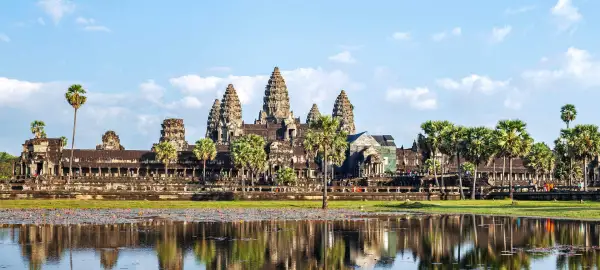Small Group Experiential Travel
Tour Code
VN2 When To Go
Mar, Nov Start
Hanoi (HAN) End
Siem Reap (SAI) Countries Visited (2)
Cambodia, Viet...More > Overnight In (9)
Phnom Penh, Si...More > Activity Level
2 - Moderate? Tour Type
Cultural? - Overview
- Info & Inclusions
- Itinerary
- Map & Hotels
- Photos
- Dates & Prices
Highlights
- Max Group Size 18
- Lan Ha Bay Overnight Cruise
- Hanoi city tour
- Hue: Perfume River sampan trip
- Charming, historic Hoi An
- Saigon & Cu Chi tunnel complex
- Mekong Delta boat trip
- Superlative Angkor Wat & Angkor Thom
- Singles friendly (view options for single travellers)
Description
Our Vietnam and Cambodia tours explore the beauty of Vietnam from the Forbidden Purple City to the soaring mountains of Ha Long Bay. In Cambodia, we step back in time and explore the amazing architecture of Angkor Wat.
Almost immediately on arrival, the vibrancy of Vietnam is felt. It a country that boasts an incredible amount of cultural diversity, and the beauty of landscapes feels timeless and unique. It is a place where modern life and historical events synchronize for an escape like none other. Combine this country with Cambodia, another jewel in the Southeast Asia region, and you'll discover why Vietnam and Cambodia tours are amongst our most popular.
The verdant hills that occupy most of the landscape of Vietnam roll eastward with soaring peaks until they reach the unspoiled beaches fringing much of this country's coastline.
In the south, the Mekong Delta although known as the rice bowl of Vietnam is as famous for its tropical fruit and flowers that grow in abundance in the area. It's a fragrant region and our Vietnam and Cambodia tours explore the many channels and canals by boat to better understand the ecosystem as well as the lives of those who call this place home.
Even in a remote channel of a river system that spans six countries, one is never far from a candid glimpse of locals selling, buying and exchanging from their boats.
Attesting to bygone times, our Vietnam and Cambodia tours will take you along Parisian styled boulevards in cities such as Hanoi, crumbling temples with religious relics such as the Cham's My Son complex, and admire the pagodas found along the Perfume River.
In the nearby Forbidden Purple City in Hue, one can absorb the ambiance of former emperors' power with a Citadel and fortress walls that resemble that of the Forbidden Palace in Beijing.
Recent struggles in Vietnam's history, from the French occupation to the Vietnam War, are best explored and understood by visiting sites such as the Cu Chi Tunnels. Originally dug by hand in the 1940s, this vast tunnel complex was used by thousands to seek refuge during the war.
Vietnam is ultimately much more than a country that suffered greatly from war in the mid-20th century. A boat ride along Lan Ha Bay, an area with incredible karst landscapes and mountains rising straight out of the water, proves just how beautiful this area is as well as why the Vietnamese are so proud to call this country home.
At the end of each day of explorations, we'll enjoy a meal in a local restaurant to taste the complex cuisine influenced by the French and Chinese, but one that utilizes local ingredients to create incredible, delicious meals.
Moving westward, our Vietnam and Cambodia tours continue to what was once the home to the Khmer Kingdom and is still home to one of the world's most incredible architectural wonders: Angkor Wat.
The 12th century temple is considered one of the finest religious structures in the world, and it is not uncommon to wander the alleys that are nearly being engulfed by jungle to discover artists and monks equally in awe of this majestic place.
If it is a region of intrigue and diversity you are after, with a chance to explore history and be amazed by the natural elements, then our Vietnam and Cambodia tours are just right for you.
Almost immediately on arrival, the vibrancy of Vietnam is felt. It a country that boasts an incredible amount of cultural diversity, and the beauty of landscapes feels timeless and unique. It is a place where modern life and historical events synchronize for an escape like none other. Combine this country with Cambodia, another jewel in the Southeast Asia region, and you'll discover why Vietnam and Cambodia tours are amongst our most popular.
The verdant hills that occupy most of the landscape of Vietnam roll eastward with soaring peaks until they reach the unspoiled beaches fringing much of this country's coastline.
In the south, the Mekong Delta although known as the rice bowl of Vietnam is as famous for its tropical fruit and flowers that grow in abundance in the area. It's a fragrant region and our Vietnam and Cambodia tours explore the many channels and canals by boat to better understand the ecosystem as well as the lives of those who call this place home.
Even in a remote channel of a river system that spans six countries, one is never far from a candid glimpse of locals selling, buying and exchanging from their boats.
Attesting to bygone times, our Vietnam and Cambodia tours will take you along Parisian styled boulevards in cities such as Hanoi, crumbling temples with religious relics such as the Cham's My Son complex, and admire the pagodas found along the Perfume River.
In the nearby Forbidden Purple City in Hue, one can absorb the ambiance of former emperors' power with a Citadel and fortress walls that resemble that of the Forbidden Palace in Beijing.
Recent struggles in Vietnam's history, from the French occupation to the Vietnam War, are best explored and understood by visiting sites such as the Cu Chi Tunnels. Originally dug by hand in the 1940s, this vast tunnel complex was used by thousands to seek refuge during the war.
Vietnam is ultimately much more than a country that suffered greatly from war in the mid-20th century. A boat ride along Lan Ha Bay, an area with incredible karst landscapes and mountains rising straight out of the water, proves just how beautiful this area is as well as why the Vietnamese are so proud to call this country home.
At the end of each day of explorations, we'll enjoy a meal in a local restaurant to taste the complex cuisine influenced by the French and Chinese, but one that utilizes local ingredients to create incredible, delicious meals.
Moving westward, our Vietnam and Cambodia tours continue to what was once the home to the Khmer Kingdom and is still home to one of the world's most incredible architectural wonders: Angkor Wat.
The 12th century temple is considered one of the finest religious structures in the world, and it is not uncommon to wander the alleys that are nearly being engulfed by jungle to discover artists and monks equally in awe of this majestic place.
If it is a region of intrigue and diversity you are after, with a chance to explore history and be amazed by the natural elements, then our Vietnam and Cambodia tours are just right for you.
Price Includes
- Breakfast and dinner daily, some lunches (see detailed itinerary for daily meal plan). All transport, accommodation, sightseeing and entrance fees for sites noted as 'visited' in the detailed itinerary. Gratuities for drivers, cruise crew, restaurant staff, porters, local guides. Airport transfers for land & air customers and for early arriving/late departing land & air customers who book their extra hotel nights through us.
Exclusions
- International airfare to/from the tour. Tour Leader gratuities, most lunches, drinks, personal items (phone, laundry, etc), domestic and international (if applicable) air taxes, visa fees, and any excursions referenced as 'optional'. Airport transfers for Land Only customers. Optional trip cancellation insurance. Our post-reservation trip notes offer further guidance on shopping, not included meals, visas and locally paid departure taxes.
Trip Info
- Seasonality and Weather:
Our October departure is just outside of the coolest time of year and the end of rainy season in Laos and Northern Vietnam; it still rains now and then, but not too much to seriously affect our trip. The scenery is green and lush, and the weather is generally pleasant at this time of year. We will likely still experience some heat, but our October visit avoids the possibility of being caught in cold weather outbreaks that tend to descend from the north Nov-Jan, which can uncomfortably chilly.
Our March date also skips the cool and cloudy winter period and the heat of summer, which begins in May. March may be somewhat less green overall as things begin to dry out; that said, it's an interesting time as it coincides with the harvest of various crops.
Coastal regions, ie Central Vietnam, are cooled by sea breezes. Down south in Cambodia, we will definitely experience some serious heat as this region known for hot and humid conditions throughout the year.
Overall you should prepare for warm-hot, sometimes sticky weather with the possibility of rain and some chilly nights/mornings in a few locales. - Transport and Travel Conditions:
Land transport throughout will be by private air-conditioned bus. Most of the driving days are not long, but progress can be slow due to the nature of the roads and traffic. Internal flights via scheduled regional carriers.
The tour is not strenuous though it is busy; you must be steady on your feet and be able to endure some heat and some long days. We have numerous walking tours and visit several sites that are LARGE with steps and uneven surfaces. Our level "2" rating for this tour refers to the ambitious itinerary, full travel days, early starts, walking tours, uneven surfaces, and the possibility of heat in some locales.
Porters are available at hotels but you must be able to manage with your baggage at airports.
Am I suitable for this tour? Please refer to our self-assessment form - Activity Level: 2
These are particularly busy tours that feature a lot of moving around, sometimes by train and short journeys on local transport. Walking tours of towns and cities are leisurely but you should be prepared to be on your feet for several hours. Some of our cultural trips that occur at high altitude and/or require greater independence with baggage handling (at hotels, airports, train stations) also fall into this category.
To learn more about the Activity levels, please visit our tour styles page. - Accommodation:
Hotels used on tour are modern, comfortable, well-located, air-conditioned, 3-4 star properties with en suite bath/toilet. Some are resort-style boutique properties with plenty of charm and atmosphere. Single rooms are limited and possibly smaller than twins. Laundry facilities are available at most hotels for a reasonable price.
Click on "Map & Hotels" tab elsewhere on this page for more info, including details about our cruise vessel. - Staff and Support:
Tour Leader throughout, local drivers, local guides at various locations. - Group Size:
Maximum 18 plus Tour Leader
View / Print Itinerary
- Day 1:Arrive in HanoiArrive in Hanoi; transfer to our hotel.
Hanoi, located on the banks of the Red River (Song Hong), is an attractive city with lakes, fine boulevards, flourishing parks, and a public centre that is an architectural museum piece. Rich in history, this is one of the most ancient capitals in the world. Hanoi is like a living museum; a fascinating glimpse into a city of old, yet oozing with the energy and pace of a modern metropolis.
Overnight in Hanoi.
Included Meal(s): Dinner, if required - Day 2:Hanoi: City ExplorationToday we explore Hanoi's historic highlights, witnessing a capital city where tree-lined boulevards, lakes, parks, belle époque villas, and Buddhist temples create a distinctive urban landscape.
We begin at the Ho Chi Minh Mausoleum, the final resting place of Vietnam's most iconic leader. The building, constructed from materials gathered from across Vietnam, closely follows the design of Lenin's Mausoleum in Moscow. Ho Chi Minh's preserved body lies in a glass case, and the site serves as a place of pilgrimage for Vietnamese visitors. The mausoleum periodically closes for maintenance, in which case we view it from the exterior only.
We continue to Ho Chi Minh's Stilt House behind the Presidential Palace. Despite his position as President of North Vietnam, Ho Chi Minh chose to live in this modest two-room house built in traditional style, elevated on wooden pillars. The building, constructed from polished and lacquered wood, demonstrates his commitment to simplicity — a stark contrast to the grandiose Presidential Palace nearby, which he never occupied.
The One Pillar Pagoda, originally built in 1049, represents one of Vietnam's most distinctive temples. The lotus-shaped structure rises from a square pool on a single stone pillar, rebuilt after French forces destroyed the original in 1954. The design symbolizes a lotus blossom emerging from muddy water, representing purity rising from an impure world.
At the Ethnology Museum, one of Vietnam's finest museums, we gain insight into the country's 54 ethnic minority groups. The indoor galleries display traditional clothing, tools, and cultural artifacts, while the outdoor section features full-scale reconstructions of minority housing styles. The museum provides essential context for understanding Vietnam's cultural diversity beyond the dominant Kinh (Vietnamese) majority.
We visit the Temple of Literature, established in 1076 as Vietnam's first national university. For nearly 700 years, this Confucian institution educated the sons of mandarins and, later, commoners who passed rigorous examinations. Stone stelae mounted on turtle pedestals record the names of successful examination candidates from 1442 to 1779, creating a remarkable historical archive. The temple's five courtyards progress from public spaces to increasingly sacred areas, culminating in the sanctuary dedicated to Confucius.
We conclude at Hoa Lo Prison Museum, known to American prisoners of war as the "Hanoi Hilton." French colonists built this prison in the late 19th century to house Vietnamese political prisoners and revolutionaries. During the Vietnam War, North Vietnam held captured American pilots here. The museum presents both periods of the prison's history, though exhibits reflect an official Vietnamese perspective on the conflicts.
Overnight in Hanoi.
Included Meal(s): Breakfast and Dinner - Day 3:Hanoi - Red River Delta & Tam CocThis morning we drive to Ninh Binh Province through the Red River Delta, northern Vietnam's agricultural heartland. The Red River (Song Hong) rises in China's Yunnan Province and flows 1,175 kilometres (730 miles) through deep gorges before entering Vietnam and discharging into the Gulf of Tonkin through a vast delta. The silt it carries is rich in iron oxide, giving the water its distinctive red colour and its name. The delta's fertile soil has supported intensive rice cultivation for millennia.
After lunch we drive to Yen Mac village, where we meet a local family to learn about daily life in the delta. Families here practice diverse agriculture, growing rice in paddies while maintaining gardens abundant with vegetables and fruit — tomatoes, aubergines, spinach, herbs, papaya, longan, and jackfruit grow in remarkable profusion. We walk along narrow village lanes to see the local pagoda and communal house, the traditional centre of village governance and ceremonies. The relaxed atmosphere encourages interaction with residents going about their daily routines.
We continue to Hoa Lu, which served as Vietnam's capital during the Dinh Dynasty (968-980) and early Le Dynasty (980-1009). We visit temples dedicated to these dynasties' rulers, set among karst limestone peaks that provided natural fortifications. After Hoa Lu, we drive across the Trang An eco-tourism complex to reach Hang Mua Cave. A climb of 450 steps brings us to the summit, where panoramic views reveal the region's remarkable landscape — often called "Halong Bay on land" — with limestone peaks rising from rice fields and waterways.
This region's combination of karst scenery, historical sites, and agricultural landscapes earned it UNESCO World Heritage designation in 2014 under the name Trang An Landscape Complex.
Overnight in Tam Coc.
Included Meal(s): Breakfast, Lunch and Dinner - Day 4:Tam Coc - Lan Ha Bay Overnight CruiseThis morning we journey to Lan Ha Bay, absorbing views of the Red River Delta and its rice fields throughout the drive. Lan Ha Bay, lying south and east of Cat Ba Town, comprises approximately 300 karst islands and limestone outcrops. Being farther from Halong City than the more famous Halong Bay, Lan Ha receives fewer tourist boats, creating a more secluded atmosphere.
We arrive at Dinh Vu port around midday and board our overnight boat. Lunch is served as we cruise toward Lan Ha Bay, entering a seascape of limestone karst peaks rising dramatically from emerald waters. These formations began as coral reefs millions of years ago; tectonic uplift and erosion created the landscape we see today.
During the afternoon we explore hidden lagoons and floating villages, observing how communities have adapted to life on the water. We have opportunities to swim or kayak at the base of the limestone cliffs, paddling through channels barely wide enough for the kayak to pass. The scale of the karst formations becomes particularly apparent at water level.
As evening approaches, we drop anchor in an isolated area. Under clear skies, the upper deck offers excellent stargazing away from city lights, while the bay's calm waters reflect the sunset's changing colours.
Overnight on board.
Included Meal(s): Breakfast, Lunch and Dinner - Day 5:Lan Ha Bay - HanoiThose interested may participate in a tai chi class on deck before breakfast, practicing gentle movements as the sun rises over the karst landscape. This morning we explore a cave system featuring thousands of stalactites and stalagmites formed over millions of years by water slowly depositing calcium carbonate.
We slowly cruise back through the karst peaks, returning to Dinh Vu port by late morning. Around noon we disembark and drive back to Hanoi, arriving in mid-afternoon.
Later this afternoon we enjoy a walking tour of Hanoi's Old Quarter, also known as the "Quarter of 36 Streets." This ancient commercial district developed between the 11th and 18th centuries, with streets organized by trade guilds — Hang Bac (Silver Street), Hang Ma (Paper Street), and so on. Many streets still specialize in particular goods, though modern shops have diversified the offerings. The narrow shophouses, typically just 3-5 metres (10-16 feet) wide but extending deep into the block, represent traditional Vietnamese urban architecture. The Old Quarter's congested streets, filled with motorcycles, vendors, and shoppers, create Hanoi's most vibrant atmosphere.
This evening we attend a water puppet show, an art form unique to Vietnam that originated in the Red River Delta. Puppeteers stand waist-deep in water behind a screen, manipulating wooden puppets that appear to move across the water's surface. The performance, accompanied by traditional instruments, depicts rural life, legends, and historical tales.
Overnight in Hanoi.
Included Meal(s): Breakfast and Dinner - Day 6:Hanoi - Da Nang - Hoi AnToday we fly to Da Nang and continue by road to Hoi An. Da Nang sits on a peninsula where the Han River flows into the South China Sea. Our route takes us past the Marble Mountains, a cluster of five limestone peaks with marble outcrops. These mountains hold religious significance for both Buddhists and followers of traditional Vietnamese beliefs, with caves housing shrines and statues. At the mountains' base, artisans craft marble objects — the stone quarrying has continued for centuries, though authorities now restrict extraction to protect the site.
We continue to Hoi An, one of Vietnam's most atmospheric towns. This ancient trading port flourished from the 15th to 19th centuries as a major Southeast Asian commercial hub, attracting Japanese, Chinese, Dutch, Portuguese, and French merchants. The town centre preserves over 1,000 timber-frame buildings, their architecture reflecting diverse influences. Hoi An's designation as a UNESCO World Heritage Site in 1999 recognized it as an exceptionally well-preserved example of a Southeast Asian trading port.
On arrival, flight times permitting, we'll have an informal orientation tour, walking through the compact old town where canals once allowed boats to deliver goods directly to merchants' houses. The town's location on the Thu Bon River, several kilometres from the coast, protected it from coastal storms that frequently damaged other ports. However, by the late 19th century, the river's silting made it inaccessible to larger ships, and trade shifted to Da Nang. This decline ironically preserved Hoi An — without economic pressure to modernize, the old buildings survived largely intact.
Overnight in Hoi An.
Included Meal(s): Breakfast and Dinner - Day 7:Hoi An: Walking Tour & Boat TripToday we explore Hoi An's old town on foot, discovering architecture that blends Vietnamese, Chinese, Japanese, and French influences. The town's wealth came from trade in ceramics, silk, pepper, and cinnamon, and successful merchants built elaborate houses that still line the streets.
Hoi An's Japanese Covered Bridge, dating to the 18th century, represents one of Vietnam's most iconic structures. The bridge connects what were historically the Japanese and Chinese quarters of town. On its northern side, a small temple serves as protection for sailors — the bridge was funded by the Japanese community but has been maintained by Chinese and Vietnamese residents over the centuries, symbolizing the town's multicultural heritage.
The Tran Family Temple has remained in the same family for 15 generations. Built in 1802 in a style combining Chinese and Japanese influences, the temple serves both as an ancestral shrine and a family home. The architecture features distinctive details — carved wooden panels, curved tile roofs, and a layout following traditional Vietnamese feng shui principles.
We visit a Chinese Assembly Hall, built by merchants from specific Chinese provinces as meeting places and temples. Hoi An has several such halls, each serving immigrants from different regions of China — Fujian, Cantonese, Hainanese, and others. The halls' ornate decorations honour Chinese deities and historical figures, with incense smoke perpetually filling the interior spaces.
At the Central Market, vendors sell fresh produce, spices, and prepared foods. The market operates daily, supplying both residents and the town's many restaurants. Hoi An's culinary reputation draws visitors specifically for dishes like cao lau (noodles unique to Hoi An), white rose dumplings, and banh mi sandwiches that Vietnamese immigrants have made famous worldwide.
We take a boat trip on the Thu Bon River, which remains essential to the region's economy and transportation more than 500 years after merchants first navigated it. The river supports fishing, agriculture, and increasingly tourism, with traditional wooden boats now carrying visitors rather than porcelain and spices.
Overnight in Hoi An.
Included Meal(s): Breakfast and Dinner - Day 8:From Hoi An: My Son Cham Dynasty ComplexThis morning we visit My Son (pronounced "mee-sohn"), a UNESCO World Heritage Site comprising over 70 architectural works from the Cham Dynasty. The Chams controlled much of central Vietnam from the 2nd to 15th centuries, establishing a Hindu kingdom influenced by Indian culture through maritime trade. My Son served as the dynasty's spiritual centre and burial ground for Cham royalty.
Construction at My Son began in the 4th century and continued for nearly 1,000 years, creating a complex of brick towers and sanctuaries dedicated primarily to Shiva. The Cham builders developed sophisticated techniques for creating bricks that bonded so tightly that researchers still debate the construction methods. Unlike the stone temples of Angkor, Cham structures used brick almost exclusively, with stone reserved for decorative elements.
The site's remote location in a mountain-ringed valley protected it for centuries after the Cham kingdom's decline. However, the Vietnam War brought devastating damage — American forces bombed My Son in 1969, mistakenly believing it harboured Vietnamese soldiers. Many structures were destroyed, though enough survived to demonstrate the Chams' architectural achievements. The remaining towers, carved sandstone lintels, and lingam shrines reveal clear influences from Indian Hindu temple design, adapted to local materials and aesthetics.
My Son's forested setting and general peacefulness create a contemplative atmosphere. The site receives far fewer visitors than Angkor, allowing time to examine details and imagine the complex during its centuries as a living religious centre.
We return to Hoi An in time for a late lunch. The remainder of the day is free to explore at leisure. The Hoi An riverside, lined with cafés, galleries, and tailor shops, bustles with activity day and night. The town is particularly known for its tailors, who can create custom clothing in as little as 24 hours — though allowing more time produces better results.
Overnight in Hoi An.
Included Meal(s): Breakfast and Dinner - Day 9:Hoi An - Da Nang - HueToday we travel to Hue, stopping first in Da Nang to visit the Museum of Cham Sculpture. This museum houses the world's largest collection of Cham art, with over 250 sandstone and terracotta sculptures dating from the 7th to 15th centuries. Many pieces rank as masterworks — the dancing apsara figures, altar pedestals carved with mythological scenes, and lingams adorned with faces display technical skill and artistic vision that place Cham sculpture among Southeast Asia's finest artistic achievements. The museum's collection comes primarily from My Son and other Cham sites throughout central Vietnam.
Shortly after leaving Da Nang, we begin climbing through the Truong Son Mountains, which historically formed the border between North and South Vietnam. Hai Van Pass, literally "Pass of the Ocean Clouds," winds through these mountains at elevations reaching 496 metres (1,627 feet). The pass offers remarkable views — mountains rising to the west, the coastline and East Sea (South China Sea) to the east. Clouds frequently obscure the summit, giving the pass its name. The pass served as a significant barrier throughout Vietnamese history, marking boundaries between kingdoms and later between the divided nation. A tunnel now allows most traffic to bypass the pass, but we take the older scenic route for its views.
Hue served as Vietnam's capital from 1802 to 1945 under the Nguyen Dynasty, the country's last royal family. The city straddles the Perfume River (Song Huong), so named for the fragrant flowers that fall into the water from trees along its banks. As the imperial capital, Hue became Vietnam's cultural, religious, and educational centre, a status it partially retains despite losing political primacy to Hanoi.
Upon arrival in Hue, we take a cyclo ride through the old city and market. Cyclos — three-wheeled bicycle taxis with passengers seated in front — appeared in Vietnam during French colonial times. They remain common in Hue despite being largely replaced by motorcycles in other Vietnamese cities. The ride provides a leisurely way to observe street life and the city's mix of colonial and Vietnamese architecture.
Overnight in Hue.
Included Meal(s): Breakfast and Dinner - Day 10:Hue: Area Tour/Citadel VisitThis morning we take a motorized boat along the Perfume River to Thien Mu Pagoda, considered Hue's finest. Built in 1601 after a local woman (the "Thien Mu" or Heavenly Lady) appeared to Governor Nguyen Hoang and identified the site as sacred, the pagoda has been rebuilt and expanded several times. Its seven-tiered tower, added in 1844, rises 21 metres (69 feet) and has become Hue's most recognizable landmark. The pagoda gained additional significance in 1963 when one of its monks, Thich Quang Duc, drove to Saigon and self-immolated to protest government persecution of Buddhists — the car he drove is preserved at the pagoda.
This afternoon we tour the Imperial City, built between 1804 and 1833 following the principles of Chinese imperial architecture. The complex sits within a walled citadel surrounded by a moat, with a perimeter of nearly 10 kilometres (6 miles). Ten gates pierce the four walls, though many suffered severe damage during the 1968 Tet Offensive, when Hue became one of the war's major battlegrounds.
The Imperial City follows the same layout as Beijing's Forbidden City — successive courtyards and gates leading to increasingly private and sacred spaces. At the complex's heart lies the Forbidden Purple City, once home to the emperor and his family. Where Beijing's Forbidden City remains largely intact, Hue's suffered devastating damage from both the Vietnam War and earlier conflicts, natural disasters, and neglect. UNESCO has supported restoration work since the site gained World Heritage status in 1993, but much remains to be done. The surviving structures, particularly the Thai Hoa Palace (Hall of Supreme Harmony) where the emperor received officials and foreign delegations, display the refinement of Vietnamese court culture through their carved wooden pillars, lacquered panels, and ceramic tile work.
This evening we enjoy dinner in a beautifully restored royal home, now owned by descendants of the Hue royal family. The setting provides an intimate glimpse into how wealthy Hue families lived, with traditional architecture adapted for tropical comfort.
Overnight in Hue.
Included Meal(s): Breakfast and Dinner - Day 11:Hue - Ho Chi Minh CityToday we fly from Hue to Ho Chi Minh City (widely still known as Saigon), Vietnam's largest city and economic engine. Where Hanoi retains a governmental and cultural focus, Ho Chi Minh City pulses with commercial energy. The city's location near the Mekong Delta on the Saigon River has made it a trading hub for centuries. French colonial rule (1859-1954) left a legacy of grand architecture, tree-lined boulevards, and café culture. Since economic reforms began in the 1980s, the city has transformed into a modern metropolis while retaining its French colonial quarter and Chinese district.
This afternoon we visit several city highlights, beginning with the Reunification Palace. This modernist building, completed in 1966, served as the residence and office of South Vietnam's president. On April 30, 1975, North Vietnamese tanks crashed through its gates, marking the end of the Vietnam War and the reunification of North and South. The building has been preserved exactly as it was that day, providing a fascinating glimpse into both the war's conclusion and the architectural tastes of the period. The palace's design incorporated bunkers, war rooms, and telecommunications facilities alongside public reception halls.
We continue to Cholon, the city's Chinatown. Ethnic Chinese have lived in this district since the 18th century, when many fled political upheaval in China. Cholon developed into a separate city before merging with Saigon in 1931. Today it remains one of the city's most vibrant areas, with Chinese temples, medicine shops, and wholesale markets doing brisk business. The architecture blends southern Chinese and Vietnamese styles, while signage appears in both Chinese characters and Vietnamese script.
Overnight in Ho Chi Minh City.
Included Meal(s): Breakfast and Dinner - Day 12:Ho Chi Minh City: Cu Chi Tunnels & War Remnants MuseumThis morning we travel outside Saigon to the Cu Chi Tunnels, one of the Vietnam War's most recognizable symbols. The tunnels began during French colonial rule in the 1940s, when Viet Minh fighters dug hiding places to store weapons and evade capture. During the Vietnam War in the 1960s, the network expanded dramatically as Viet Cong forces created an underground city beneath Cu Chi district.
The tunnel system eventually stretched over 250 kilometres (155 miles), with living quarters, kitchens, storage areas, hospitals, and command centres all located underground. Despite intensive American bombing campaigns that turned the district into one of the most bombed areas in history, Cu Chi residents continued their lives beneath the soil — sleeping, eating, planning operations, treating the wounded, and educating children in underground classrooms.
Today, sections of the tunnels have been widened slightly to accommodate visitors — the original passages measured only 60-80 centimetres (24-31 inches) wide, forcing people to crawl. Those comfortable with confined spaces can experience what movement through the tunnels entailed, though claustrophobic visitors may prefer to observe from above ground, where camouflaged trapdoors and ventilation systems demonstrate the network's ingenious design.
We return to the city and visit the War Remnants Museum, Vietnam's most comprehensive wartime documentation centre. The museum presents the conflicts from a Vietnamese perspective, with exhibits covering French colonial rule and the subsequent American war. Some displays contain graphic images of war's effects on civilians and soldiers. The outdoor courtyard displays captured American military equipment, including aircraft, tanks, and artillery. While the museum's narrative reflects official Vietnamese viewpoints and includes anti-American propaganda, it does document the war's human costs and the long-term effects of defoliants like Agent Orange.
Overnight in Ho Chi Minh City.
Included Meal(s): Breakfast and Dinner - Day 13:Ho Chi Minh City - Cao Dai Temple - Mekong DeltaOur destination today is the Mekong Delta, where Southeast Asia's most important river approaches the sea through a network of tributaries and channels. En route we stop at a Cao Dai temple to observe this uniquely Vietnamese religion. Cao Dai emerged in southern Vietnam during the 1920s after Ngo Van Chieu, a civil servant, experienced visions of the "Cao Dai" or "Supreme Being," who instructed him to establish a new faith.
Cao Dai attempts to synthesize major world religions — Buddhism, Taoism, Confucianism, Christianity, and Islam — into a single practice. The religion's symbol, a giant eye representing the Supreme Being, appears prominently in temples and on the religion's flag. The faith gained rapid support among dispossessed peasants and today claims approximately two million adherents and 1,000 temples across Vietnam. The main temple we visit displays remarkable eclecticism, with dragons winding up columns, Christian saints depicted alongside Buddha and Confucius, and French poet Victor Hugo honoured as a saint. If we time our visit correctly, we may observe a ceremony where priests in colourful robes — yellow for Buddhism, red for Confucianism, blue for Taoism — conduct services.
We continue south to the Mekong Delta, the southernmost region of Vietnam. The Mekong River travels 4,350 kilometres (2,703 miles) from the Tibetan Plateau through six countries before reaching Vietnam. Here it fragments into a web of channels and distributaries that the Vietnamese call "Cuu Long," the Nine Dragons. The river deposits massive amounts of sediment, creating exceptionally fertile soil that supports three rice crops annually — earning the delta its nickname as Vietnam's rice bowl. The delta also produces tropical fruits, coconuts, sugarcane, and vast quantities of fish and prawns from its waterways.
Traditional transportation throughout the delta relies on boats navigating the network of canals and channels. Tomorrow morning we'll experience these waterways firsthand at one of the region's floating markets.
NOTE: Please pack an overnight bag for the Mekong Delta trip. Large baggage will be securely stored in Ho Chi Minh City.
Overnight in hotel in Cantho region (Mekong Delta).
Included Meal(s): Breakfast and Dinner - Day 14:Mekong Delta - Ho Chi Minh City / Colonial QuarterEarly this morning we take a covered boat ride on the delta to visit a floating market, where traders conduct business from their boats rather than from fixed locations. Vendors specialize in particular products — one boat might sell only pineapples, another only coconuts — and advertise their wares by hanging samples from tall poles. Larger boats serve as wholesalers, while smaller vessels function as retailers or restaurants, creating a complete marketplace on water. The floating markets represent centuries-old trading traditions, though they're gradually declining as roads improve and land-based commerce grows more convenient.
Due to the delta's flat terrain and limited forested areas, nearly two-thirds of the land supports agriculture. The Mekong Delta produces more than half of Vietnam's rice output and serves as the country's most important fishing region, with both river and coastal waters providing abundant catches.
After our morning exploration, we drive back to Ho Chi Minh City, arriving early afternoon. We complete any city sightseeing not accomplished earlier in our visit, including the Colonial Quarter. Here we find the Notre Dame Cathedral and adjacent Central Post Office, both constructed by the French in the 1880s. The cathedral, situated in what the French called Paris Square (now Công trường Công xã Paris), ranks among Vietnam's largest Catholic churches. Built entirely from materials imported from France, including red bricks from Marseille, it displays the neo-Romanesque style popular in late 19th-century Europe. The twin bell towers rise 58 metres (190 feet) and once held bells cast in France.
The Central Post Office, designed by Gustave Eiffel's architectural firm, features a vast interior hall with arched windows, decorative tilework, and an enormous map of southern Vietnam and Cambodia from the French colonial period. The building remains a functioning post office, though it now serves primarily as a tourist attraction. Both structures exemplify French colonial architecture adapted for tropical conditions, with high ceilings and large windows designed to provide natural cooling.
Overnight in Ho Chi Minh City.
Included Meal(s): Breakfast and Dinner - Day 15:Ho Chi Minh City, Vietnam - Phnom Penh, CambodiaToday we fly from Ho Chi Minh City to Phnom Penh, Cambodia's capital and largest city. Phnom Penh sits at the confluence of the Mekong, Tonle Sap, and Bassac rivers — a strategic location that has made it Cambodia's most important city for centuries. The city served as the Khmer royal capital intermittently from the 15th century, becoming the permanent capital in 1866.
French colonists, who controlled Cambodia from 1863 to 1953, transformed Phnom Penh into what they considered the "Pearl of Asia," building grand boulevards, colonial villas, and public buildings. The city's tree-lined streets and French architecture survived relatively intact until the Khmer Rouge period (1975-1979), when the regime forcibly evacuated the entire urban population to rural work camps. When Vietnamese forces drove out the Khmer Rouge in 1979, they found an abandoned city. Phnom Penh has since recovered, though many colonial-era buildings remain in states of disrepair.
The city takes its name from Wat Phnom ("Temple on a Hill"), a Buddhist temple on a small artificial hill that local legend credits to a woman named Penh who found Buddha statues washed ashore and had the hill built to house them properly.
Depending on our arrival time, we may accomplish some sightseeing as described for tomorrow.
Overnight in Phnom Penh.
Included Meal(s): Breakfast and Dinner - Day 16:Phnom Penh: Tuol Sleng Prison & City TourToday we confront Cambodia's traumatic recent history, beginning with a visit to Tuol Sleng Genocide Museum. This former high school was converted by the Khmer Rouge into Security Prison 21 (S-21), the regime's largest torture and interrogation centre. Between 1975 and 1979, approximately 20,000 people passed through Tuol Sleng — political prisoners, intellectuals, suspected dissidents, ethnic Vietnamese and Chinese, and eventually Khmer Rouge members accused of treachery. Prisoners were photographed upon arrival, interrogated under torture to produce false confessions, and then transported to execution sites. Only seven prisoners survived.
The buildings remain largely as they were found in January 1979 when Vietnamese forces liberated Phnom Penh. Classrooms became tiny cells or torture chambers, their transformation documented by photographs that line the walls — thousands of black and white images of prisoners, their faces showing fear, defiance, or resignation. The museum serves as both a memorial and a historical record, ensuring that the Khmer Rouge's crimes are not forgotten.
We continue to Choeung Ek, one of nearly 400 "Killing Fields" scattered across Cambodia where the Khmer Rouge executed prisoners. Located 17 kilometres (11 miles) from the city, Choeung Ek served as the primary execution ground for Tuol Sleng prisoners. Approximately 17,000 people were killed here. A tall stupa now houses over 5,000 skulls exhumed from mass graves. Walking paths lead past excavated pits and beneath trees that were used to execute children — the site's brutality is difficult to comprehend. An audio guide provides survivor testimony and explains the site's history.
Returning to Phnom Penh, we visit the National Museum, which houses one of the world's largest collections of Khmer art. The museum's collection includes over 14,000 objects spanning prehistoric times through the Angkorian period and beyond. Stone sculptures from Angkor and pre-Angkorian sites form the centrepiece — standing Buddhas, dancing apsaras, lingams, and architectural elements demonstrate the evolution of Khmer artistic styles over more than 1,000 years. The museum building itself, constructed between 1917 and 1924, takes design inspiration from Khmer temple architecture, with a central courtyard and terracotta-coloured walls.
We walk to the nearby Royal Palace, the official residence of Cambodia's king since the 1860s (though the current king resides elsewhere). While parts remain off-limits, we visit the Throne Hall and Silver Pagoda. The Silver Pagoda, named for its floor of 5,000 silver tiles, houses Cambodia's most sacred Buddha images, including an emerald Buddha and a life-sized gold Buddha encrusted with diamonds. The pagoda's walls display frescoes depicting the Reamker, the Cambodian version of the Hindu Ramayana epic.
We conclude at Wat Phnom, the temple-topped hill that gives the city its name. Built in 1372 and rebuilt several times since, the temple remains an active place of worship. From the hilltop, views extend across Phnom Penh's distinctive mix of colonial buildings, modern construction, and traditional wooden houses.
Overnight in Phnom Penh.
Included Meal(s): Breakfast and Dinner - Day 17:Phnom Penh - Siem Reap & Angkor WatThis morning we fly to Siem Reap, gateway to the ancient temples of Angkor. The town sits on the edge of Southeast Asia's most important archaeological site — the remains of the Khmer Empire, which dominated the region from the 9th to 15th centuries. At its height, Angkor was one of the world's largest pre-industrial cities, home to over a million people.
This afternoon we visit Angkor Wat, the best-preserved temple in the complex and the world's largest religious monument. Built in the early 12th century by King Suryavarman II, it was originally dedicated to the Hindu god Vishnu before becoming a Buddhist temple in the 14th century. The temple's five towers represent Mount Meru, the mythical home of the gods in Hindu cosmology, while its extensive bas-reliefs depict scenes from Hindu epics and Khmer history.
We continue to Angkor Thom, the fortified capital city built by King Jayavarman VII in the late 12th century. We enter through the South Gate, where giant stone faces gaze out in four directions. At the city's centre stands Bayon Temple, famous for its 54 towers bearing serene stone faces — likely representing the bodhisattva Avalokiteshvara or perhaps the king himself. The Baphuon, a massive temple-mountain, represents another architectural achievement of the period.
We also visit the Elephant Terrace, used for royal ceremonies and public audiences, and the Terrace of the Leper King, adorned with intricate carvings. Both terraces showcase the engineering and artistic sophistication of Angkor's builders.
NOTE: The order of Siem Reap sightseeing may vary at the discretion of your Tour Leader.
Overnight in Siem Reap.
Included Meal(s): Breakfast and Dinner - Day 18:Siem Reap: Angkor ThomToday we explore the Petit and Grand Circuits, two routes established by early archaeologists to organize visits to Angkor's sprawling temple complex. These circuits connect dozens of temples beyond Angkor Wat, each revealing different aspects of Khmer architectural and artistic development.
We begin at Ta Prohm, deliberately left in its overgrown state to show how the jungle reclaimed Angkor after the city's decline. Massive silk-cotton and strangler fig trees grow from the temple's walls and courtyards, their roots prying apart the ancient stones. Built in the late 12th century as a Buddhist monastery and university, Ta Prohm once housed over 12,000 people, including 18 high priests and 615 dancers.
We continue to Ta Keo, notable as the first Angkorian temple built entirely from sandstone rather than brick. Its unfinished state — the temple was never decorated with bas-reliefs — provides insight into Khmer construction techniques. Nearby, Sras Srang (Pool of Ablutions) served as a royal bathing pool, its laterite steps leading down to water that still fills the reservoir during rainy season.
At Preah Khan, a massive monastic complex built by King Jayavarman VII, we explore the labyrinthine galleries and courtyards that once formed a Buddhist university. The temple's name means "Sacred Sword," and it served both religious and administrative functions during Angkor's golden age. Pre Rup, with its brick sanctuaries glowing red in certain light, represents an earlier architectural style from the 10th century.
The scale of Angkor becomes clear as we move between these sites. The complex covered several square kilometres, with sophisticated hydraulic systems — canals and reservoirs called barays — that controlled flood waters and provided irrigation during droughts. This engineering allowed Angkor to support what may have been the world's largest city in the 12th century, with populations estimated at one million inhabitants.
Overnight in Siem Reap.
Included Meal(s): Breakfast and Dinner - Day 19:Siem Reap: Banteay SreiToday we venture beyond the main Angkor complex to visit temples farther afield, traveling through the Cambodian countryside where rice paddies and rural villages provide glimpses of daily life that has changed little over centuries. The journey itself offers a different perspective on the region, showing how the great temples existed within a much larger agricultural landscape.
Our primary destination is Banteay Srei, considered by many to be the jewel of Khmer art. Built in AD 967, this temple stands apart from Angkor's other monuments in several ways. Unlike the massive royal projects we've been exploring, Banteay Srei was commissioned by Yajnavaraha, a Brahman priest and spiritual advisor to King Jayavarman V. Originally called Tribhuvana Mahesvara, it stood in the town of Isvarapura, about 25 kilometres (15 miles) northeast of the main Angkor group.
The temple's current name, Banteay Srei, means "Citadel of Women" or "Citadel of Beauty" — a reference to the delicate artistry of its carvings rather than any historical association with women. Built on a smaller scale than Angkor's royal temples and constructed from fine-grained pink sandstone, Banteay Srei allowed artisans to create extraordinarily detailed relief work. The lintels, pediments, and standing figures display a level of craftsmanship unmatched elsewhere in the Angkor complex, with scenes from Hindu epics rendered in miniature precision.
Banteay Srei was one of the first temples restored by French archaeologists using the anastylosis technique — carefully dismantling and rebuilding structures using as many original stones as possible. This restoration, begun in 1931, served as a model for later conservation work throughout Angkor.
Overnight in Siem Reap.
Included Meal(s): Breakfast and Dinner - Day 20:DepartureDeparture from Siem Reap.
BON VOYAGE! Aw khun chran (Thank you in Khmer)!
Included Meal(s): Breakfast
Regions Visited: Asia and Southeast Asia
Countries Visited: Cambodia and Vietnam
Countries Visited: Cambodia and Vietnam
*The red tour trail on the map does not represent the actual travel path.

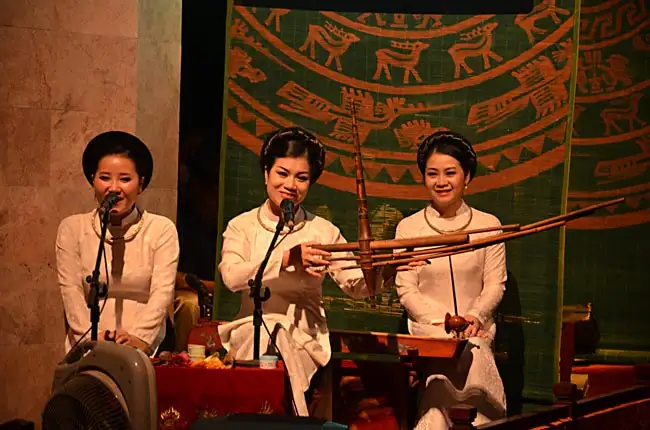
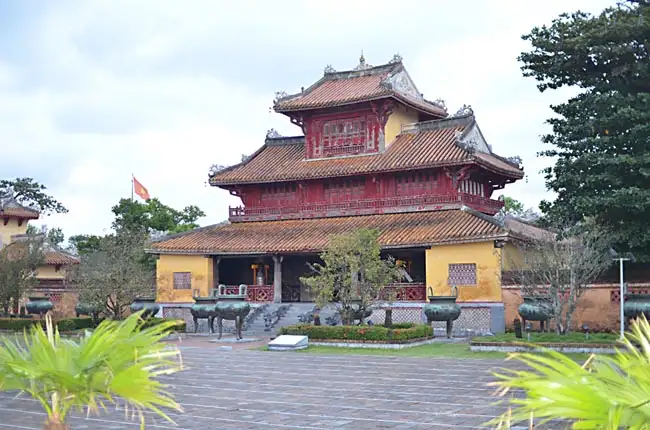
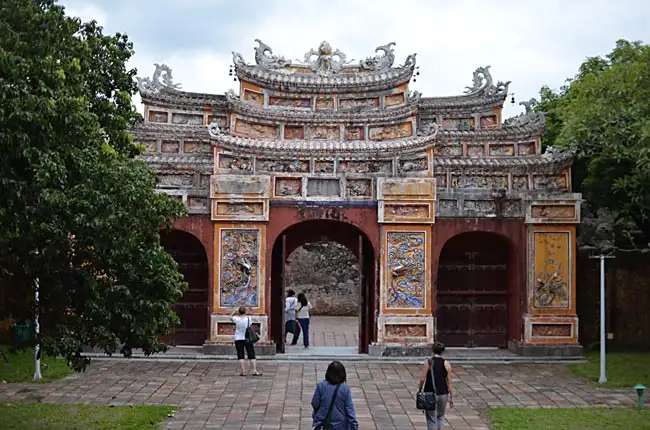
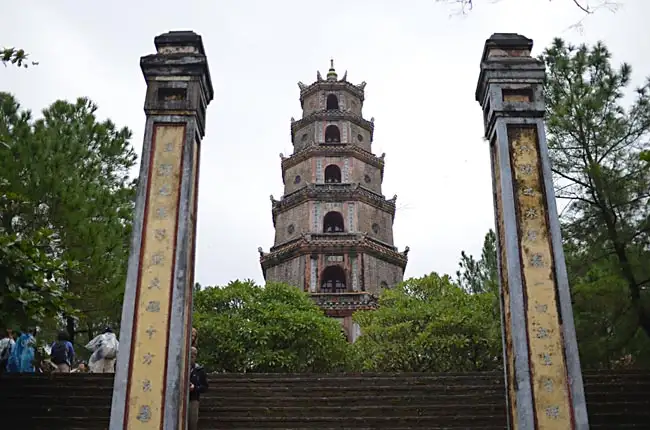


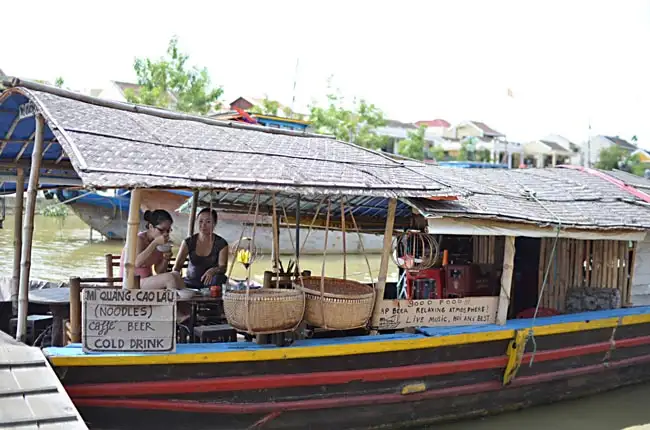

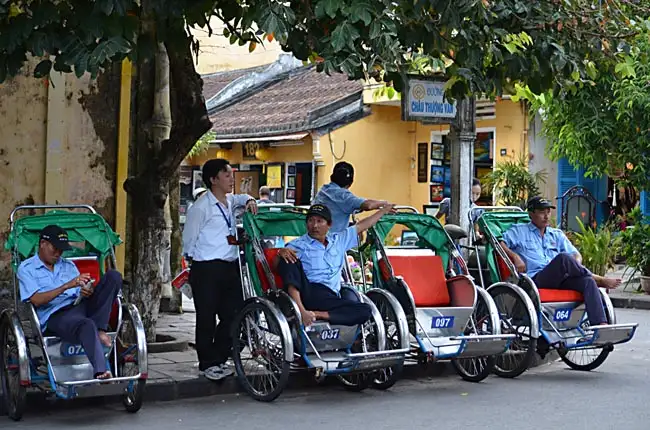
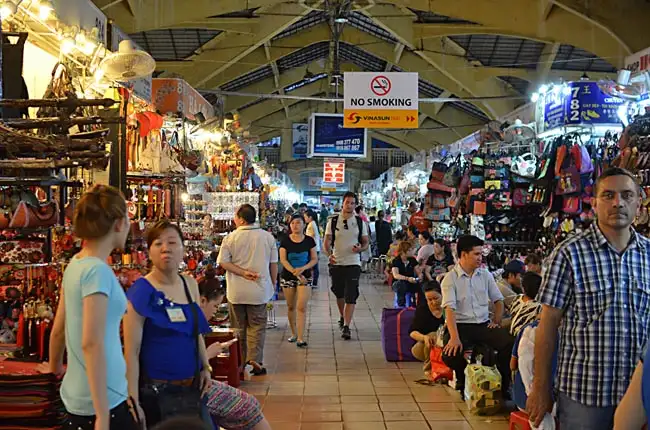

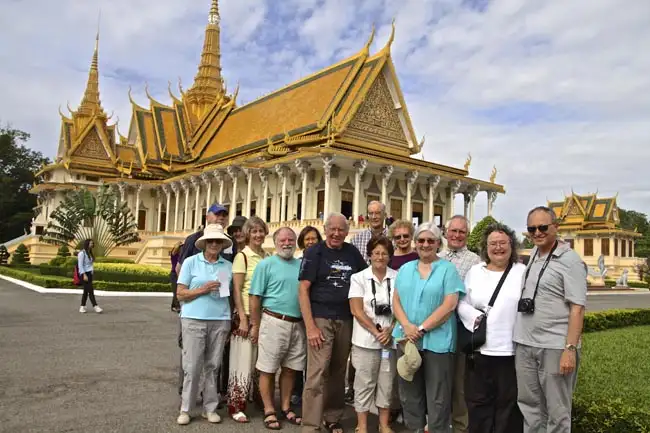
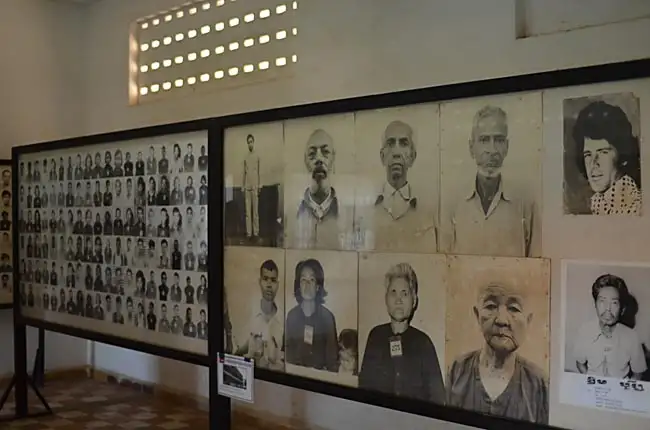

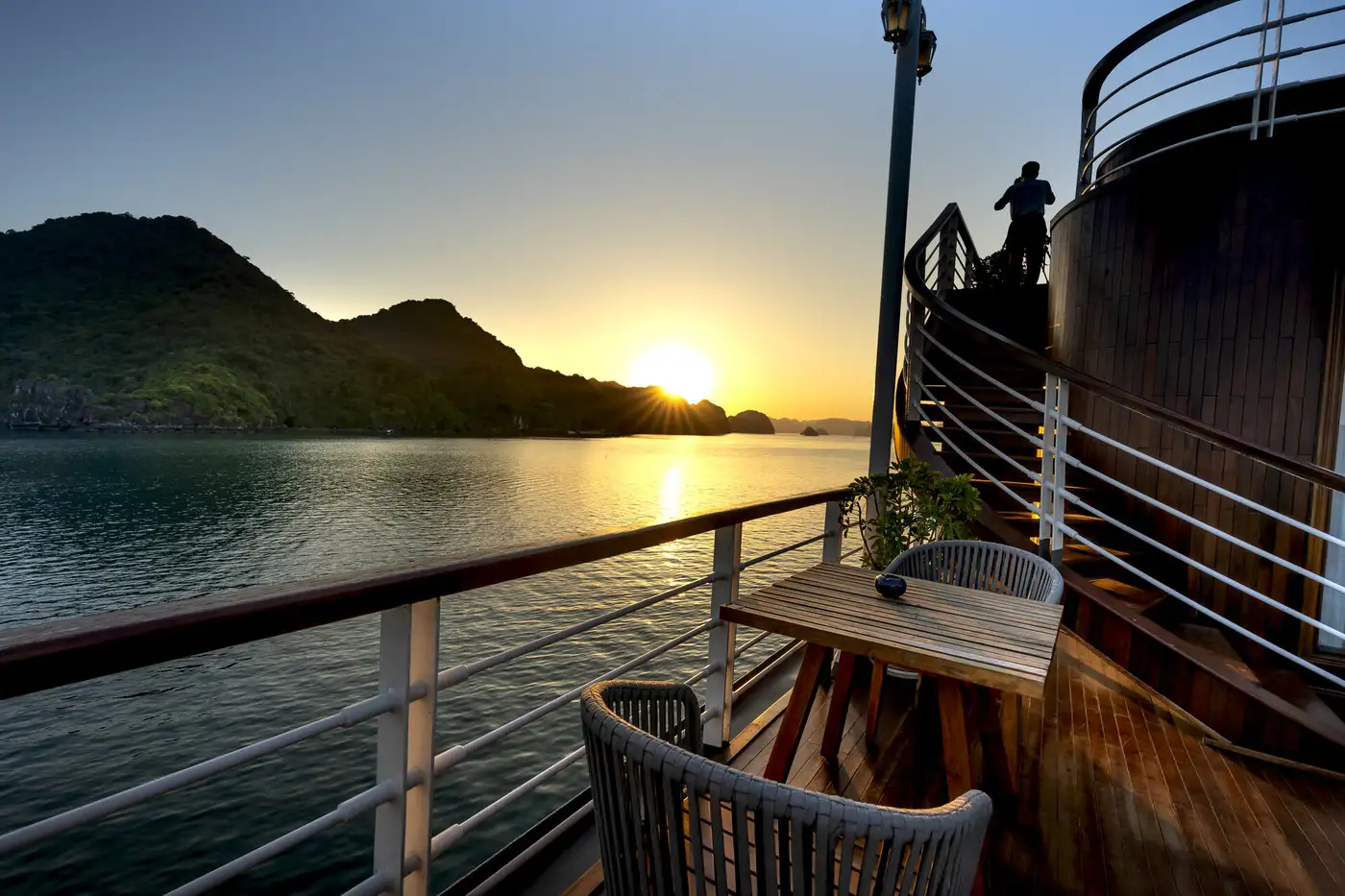

Excellent
Overall Rating
4.7
Extend Your Trip
This tour is part of a series that can be upgraded to make for a longer trip.

Fast and easy
Book This Tour
Book your unforgettable adventure today! For any questions or advice, don't hesitate to contact us.
Have questions?
1-800-665-3998
- Final payment: Due 90 days prior to departure.
- Deposit: A non-refundable $500 CAD Deposit is required at booking.
- Internal Flight Taxes: An extra $100 CAD applies for taxes and fees on tour flights. The internal airfares are included, but taxes are listed separately as they may change. Exceptions are noted in Red.
- Optional Single Supplement: $1440 CAD (number of singles limited).
(View options forsingle travellers) - Transfering Tour or Date: Transferring to another tour or tour date is only permissible outside of 120 days prior to departure and is subject to a $100 CAD change fee.
(Read our cancellation policy)
Choose your departure date:
Prices below are per person, twin-sharing costs in Canadian Dollars (CAD). Pricing does not include airfare to/from the tour and any applicable taxes.
Prices below are per person, twin-sharing costs in Canadian Dollars (CAD). Pricing does not include airfare to/from the tour and any applicable taxes.
Frequently Asked Questions
- What is the maximum number of participants on a trip?Most of our tours carry a maximum of 18 participants; some tours (ie hiking tours) top out at 16. In the event that we do not achieve our minimum complement by our 90-day deadline, we may offer group members the option of paying a "small-group surcharge" as an alternative to cancellation. If all group members agree, we will confirm the trip at existing numbers; this surcharge is refundable in the event that we ultimately achieve our regular minimum. If the small group surcharge is not accepted, we will offer a refund of your deposit or a different trip of your choice.
- Can I extend my tour either at the beginning or end? What about stopovers?Yes, you can extend your tour either at the beginning or the end and we can book accommodation in our tour hotel. Stopovers are often permitted, depending on air routing. Stopovers usually carry a "stopover" fee levied by the airline.
- How do I make a reservation? How and when do I pay?The easiest way to make a reservation is via our website; during office hours, you are also more than welcome to contact us by telephone.
A non-refundable deposit is payable at the time of booking; if a reservation is made within 90 days, full payment is required. Some trips require a larger deposit. If international airline bookings require a non-refundable payment in order to secure space or the lowest available fare, we will require an increase in deposit equal to the cost of the ticket(s).
Early enrolment is always encouraged as group size is limited and some trips require greater preparation time.
Once we have received your deposit, we will confirm your space and send you a confirmation package containing your trip itinerary, any visa/travel permit related documents, invoice, clothing and equipment recommendations, general information on your destination(s), and forms for you to complete, sign and return to us. Your air e-tickets (if applicable), final hotel list, final trip itinerary, and instructions on how to join your tour, will be sent approximately 2-3 weeks prior to departure. - What about cancellations, refunds, and transfers?Please review our cancellation policy page for details.
- I am a single who prefers my own room. What is a single supplement?All of our tours have a single supplement for those who want to be guaranteed their own room at each location.
This supplement is a reflection of the fact that most hotels around the world do not discount the regular twin-share rate for a room by 50% for only one person occupying a room. Most hotels will give a break on the price, but usually in the range of 25-30% of the twin-share rate. This difference, multiplied by each night, amounts to the single supplement.
The conventional amount can also vary from country to country and some destinations are more expensive than others for single occupancy. In order to be "single friendly," the supplements we apply are not a profit centre for us and we do our best to keep them as reasonable as possible.
On most tours we limit the number of singles available, not to be punitive, but rather because many hotels allow for only a limited number of singles; some smaller hotels at remote locations also have a limited number of single rooms available.
Please note that most single rooms around the world are smaller than twin-share rooms and will likely have only one bed. - Do you have a shared accommodation program?Yes! If you are single traveller and are willing to share, we will do our best to pair you with a same-gender roommate. Please note that should we fail to pair you, we will absorb the single supplement fee and you will default to a single room at no extra charge.
